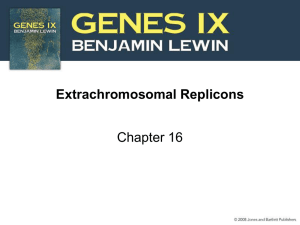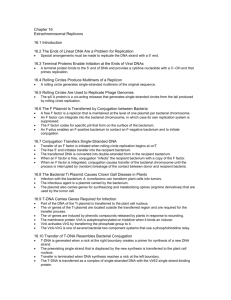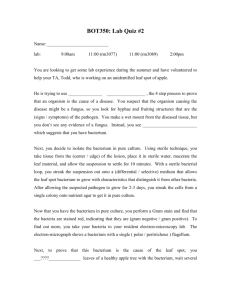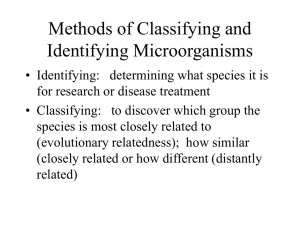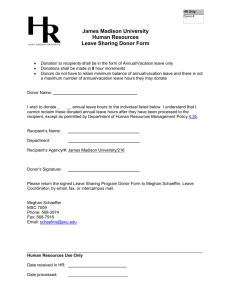Genetic Transfer & Recombination In Bacteria
advertisement
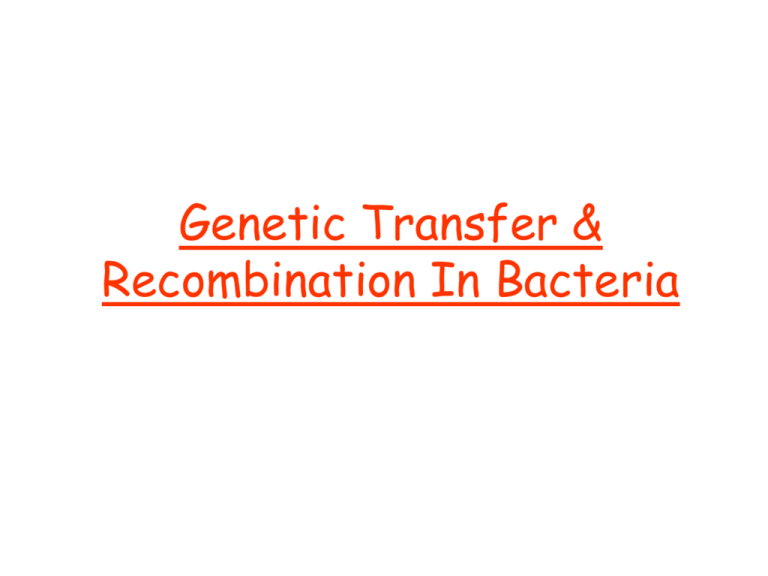
Genetic Transfer & Recombination In Bacteria • Genetic recombination - transfer of DNA from one organism (donor) to another recipient. The transferred donor DNA may then be integrated into the recipient's nucleoid by various mechanisms (homologous, non-homologous). • Homologous recombination- homologous DNA sequences having nearly the same nucleotide sequences are exchanged by means of Rec A proteins. This involves breakage and reunion of paired DNA segments as seen in (Natural mechanisms of genetic recombination in bacteria include: a. transformation b. transduction c. conjungation Transformation • Genetic recombination in which a DNA fragment from a dead, degraded bacterium enters a competent recipient bacterium and it is exchanged for a piece of the recipient's DNA. • Involves 4 steps http://www.cat.cc.md.us/courses/bio141/lecguide/unit4/genetics/recombination/transformation/transformation.html The 4 steps in Transformation 1. A donor bacterium dies and is degraded 2. A fragment of DNA from the dead donor bacterium binds to DNA binding proteins on the cell wall of a competent, living recipient bacterium 3. The Rec A protein promotes genetic exchange between a fragment of the donor's DNA and the recipient's DNA 4. Exchange is complete Transduction • Genetic recombination in which a DNA fragment is transferred from one bacterium to another by a bacteriophage Structure of T4 bacteriophage Contraction of the tail sheath of T4 What are Bacteriophages? Bacteriophage (phage) are obligate intracellular parasites that multiply inside bacteria by making use of some or all of the host biosynthetic machinery (i.e., viruses that infect bacteria Transduction (cont’d) • There are two types of transduction: – generalized transduction: A DNA fragment is transferred from one bacterium to another by a lytic bacteriophage that is now carrying donor bacterial DNA due to an error in maturation during the lytic life cycle. – specialized transduction: A DNA fragment is transferred from one bacterium to another by a temperate bacteriophage that is now carrying donor bacterial DNA due to an error in spontaneous induction during the lysogenic life cycle Seven steps in Generalised Transduction 1. A lytic bacteriophage adsorbs to a susceptible bacterium. 2. The bacteriophage genome enters the bacterium. The genome directs the bacterium's metabolic machinery to manufacture bacteriophage components and enzymes 3. Occasionally, a bacteriophage head or capsid assembles around a fragment of donor bacterium's nucleoid or around a plasmid instead of a phage genome by mistake. Seven steps in Generalised Transduction (cont’d) 4. The bacteriophages are released. 5. The bacteriophage carrying the donor bacterium's DNA adsorbs to a recipient bacterium Seven steps in Generalised Transduction (contd) 6. The bacteriophage inserts the donor bacterium's DNA it is carrying into the recipient bacterium . 7. The donor bacterium's DNA is exchanged for some of the recipient's DNA. http://www.cat.cc.md.us/courses/bio141/lecguide/unit4/genetics/recombination/tran sduction/transduction.html Six steps in Specialised Transduction 1. A temperate bacteriophage adsorbs to a susceptible bacterium and injects its genome . 2. The bacteriophage inserts its genome into the bacterium's nucleoid to become a prophage. Six steps in Specialised Transduction (cont’d) 3. Occasionally during spontaneous induction, a small piece of the donor bacterium's DNA is picked up as part of the phage's genome in place of some of the phage DNA which remains in the bacterium's nucleoid. 4. As the bacteriophage replicates, the segment of bacterial DNA replicates as part of the phage's genome. Every phage now carries that segment of bacterial DNA. Six steps in Specialised Transduction (cont’d) 5. The bacteriophage adsorbs to a recipient bacterium and injects its genome. 6. The bacteriophage genome carrying the donor bacterial DNA inserts into the recipient bacterium's nucleoid. http://www.cat.cc.md.us/courses/bio141/lecguide/unit4/genetics/recombination/transduction/spectran.html Bacterial Conjugation Bacterial Conjugation is genetic recombination in which there is a transfer of DNA from a living donor bacterium to a recipient bacterium. Often involves a sex pilus. • The 3 conjugative processes + I. F conjugation II. Hfr conjugation III. Resistance plasmid conjugation I. F+ Conjugation Process F+ Conjugation- Genetic recombination in which there is a transfer of an F+ plasmid (coding only for a sex pilus) but not chromosomal DNA from a male donor bacterium to a female recipient bacterium. Involves a sex (conjugation) pilus. Other plasmids present in the cytoplasm of the bacterium, such as those coding for antibiotic resistance, may also be transferred during this process. The 4 stepped F+ Conjugation 1. The F+ male has an F+ plasmid coding for a sex pilus and can serve as a genetic donor 2. The sex pilus adheres to an F- female (recipient). One strand of the F+ plasmid breaks The 4 stepped F+ Conjugation (cont’d) 3. The sex pilus retracts and a bridge is created between the two bacteria. One strand of the F+ plasmid enters the recipient bacterium 4. Both bacteria make a complementary strand of the F+ plasmid and both are now F+ males capable of producing a sex pilus. There was no transfer of donor chromosomal DNA although other plasmids the donor bacterium carries may also be transferred during F+ conjugation. http://www.cat.cc.md.us/courses/bio141/lecguide/unit4/genetics/recombination/conjugation/f.htm l II. Hfr Conjugation Genetic recombination in which fragments of chromosomal DNA from a male donor bacterium are transferred to a female recipient bacterium following insertion of an F+ plasmid into the nucleoid of the donor bacterium. Involves a sex (conjugation)pilus. 5 stepped Hfr Conjugation 1. An F+ plasmid inserts into the donor bacterium's nucleoid to form an Hfr male. 2. The sex pilus adheres to an Ffemale (recipient). One donor DNA strand breaks in the middle of the inserted F+ plasmid. 5 stepped Hfr Conjugation (cont’d) 3. The sex pilus retracts and a bridge forms between the two bacteria. One donor DNA strand begins to enter the recipient bacterium. The two cells break apart easily so the only a portion of the donor's DNA strand is usually transferred to the recipient bacterium. 4. The donor bacterium makes a complementary copy of the remaining DNA strand and remains an Hfr male. The recipient bacterium makes a complementary strand of the transferred donor DNA. 5 stepped Hfr Conjugation (cont’d) 5. The donor DNA fragment undergoes genetic exchange with the recipient bacterium's DNA. Since there was transfer of some donor chromosomal DNA but usually not a complete F+ plasmid, the recipient bacterium usually remains F- http://www.cat.cc.md.us/courses/bio141/lecguide/unit4/genetics/recombination/conjugation/hfr.htm l III. Resistant Plasmid Conjugation Genetic recombination in which there is a transfer of an R plasmid (a plasmid coding for multiple antibiotic resistance and often a sex pilus) from a male donor bacterium to a female recipient bacterium. Involves a sex (conjugation) pilus 4 steped Resistant Plasmid Conjugation 1. The bacterium with an R-plasmid is multiple antibiotic resistant and can produce a sex pilus (serve as a genetic donor). 2. The sex pilus adheres to an F- female (recipient). One strand of the R-plasmid breaks. 4 stepped Resistant Plasmid Conjugation (cont’d) 3. The sex pilus retracts and a bridge is created between the two bacteria. One strand of the R-plasmid enters the recipient bacterium. 4. Both bacteria make a complementary strand of the R-plasmid and both are now multiple antibiotic resistant and capable of producing a sex pilus. http://www.cat.cc.md.us/courses/bio141/lecguide/unit4/genetics/recombination/conjugation/r.html
